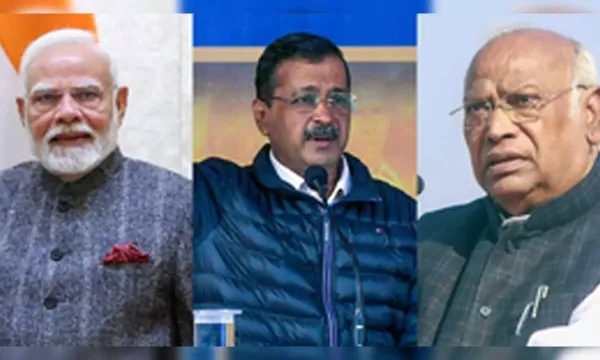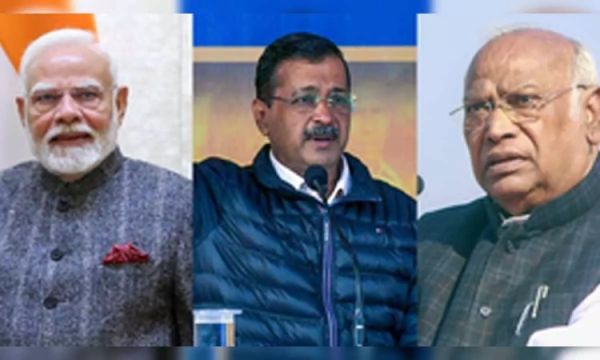
Voters overwhelmingly supported the AAP in Delhi’s last two Assembly elections in 2020 and 2015, giving it 53.6% and 54.3% of the vote, respectively. This is encouraging for the ruling party, which is hoping to secure a respectable number of seats even in the upcoming polls on February 5 despite pressure from the Congress and the BJP.

Even in the worst case, the AAP believes that their vote share would never fall so precipitously that the party will lose. They want to remain influential in Delhi politics.
The Congress’ performance and its capacity to reduce the AAP’s support base, which consists of Muslims, slum dwellers, Purvanchalis, and other inhabitants of unapproved colonies who support former Delhi Chief Minister Arvind Kejriwal’s welfare programs, will determine the BJP’s victory in the Delhi Assembly elections, as pollsters have repeatedly stated.
In 2020, the AAP won 62 seats (vote share of 53.6%) with a total turnout of 62.82 percent. In 2015, the AAP secured 67 seats.
The BJP took home three seats in 2015 and eight in 2020. In 2020, the saffron party received 38.5% of the vote. In 2020, the Congress received 4.26 percent of the vote.
Overall voter participation in 2015 was 67.47 percent, with the AAP’s vote share at 54.3%, up 24.8 percent from the previous election in 2013, and its seats climbing from 28 to 67, a 39 percent increase.
The BJP’s seats dropped from 32 in 2013 to 3 in the same election, while their vote share decreased by 0.8% to 32.3%. The Congress failed to open its tally, losing eight members, and its vote share was 9.7%, down 14.9%.
The Congress lost all of its supporters to the new party in this election, which was a turning point for the party. The AAP gained a vote share that the Congress lost by 14.9%.
The Modi Effect: The BJP’s vote share rose from 32.3% to 38.5% between the 2015 and 2020 elections. After seeing the performance of the Narendra Modi administration at the center during a five-year term, BJP supporters and other Delhi voters cast their ballots for the first time in the 2020 Assembly election.
The Modi administration was just one year old before the 2015 elections, and Delhi residents had not witnessed his performance in a while.
Voters are now aware of the ‘Modi Magic’ and his track record of keeping promises; thus, if past results are any guide, the BJP’s support and vote share are expected to increase in the next elections.
Given that the prime minister has promised to make Delhi a global capital and has assured the continuation of all free welfare programs provided by the AAP in the nation’s capital, there is a very good chance that Delhi residents will vote on Modi’s face value, just as they did in Haryana and Maharashtra.
According to pollsters, if both the AAP and the BJP provide free welfare services, the clean image of the two parties’ main leaders—AAP Vice President Arvind Kejriwal and BJP Prime Minister Modi—could be the deciding factor.
A political science professor from Delhi University warned that the BJP would need to counter Kejriwal’s ability to win over voters by accusing him of being victimized by the Center and slapping him with “false” corruption cases. “Such a Modi versus Kejriwal clash in Delhi could give the BJP an edge due to the corruption allegations against the AAP leader,” the professor said.
Voter turnout: The main elements that might affect the outcome of the next elections for both the AAP and the BJP are still a high voter turnout, a strong showing by the Congress in terms of vote share, and a ban on fraudulent voting.
The Congress’s better performance could only serve to preserve the city’s magnificent old party, whose identity is slowly being undermined.
In the 2015 Assembly elections, the North West district of Delhi had the highest turnout, at 68.58 percent, followed by Shahdara district at 65.81 percent and East district at 64.26 percent.
As the AAP has repeatedly promised free water, electricity, health care, sewers, and roads, the high turnout in the trans-Yamuna region is perhaps a reflection of the high hopes of the people living in unplanned and unauthorized communities.
Voter indifference in more established colonies, where inhabitants already have adequate infrastructure and are mostly ineligible for free electricity and water, is reflected in the lowest turnout, 56.24 percent, in the New Delhi district. Constituencies including Patel Nagar, Delhi Cantonment, Rajender Nagar, New Delhi, R.K. Puram, and Greater Kailash are located within the district.